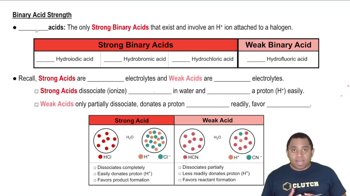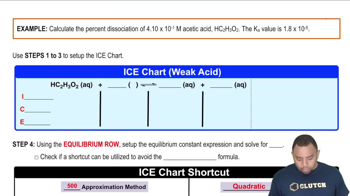Which of the following solutions is the most acidic? a. 0.2 M LiOH b. 0.2 M HI c. 1.0 M methanol (CH3OH)
Ch.4 - Reactions in Aqueous Solution
Chapter 4, Problem 33b
State whether each of the following statements is true or false. Justify your answer in each case. (b) HCl is a weak acid.
 Verified step by step guidance
Verified step by step guidance1
Identify the nature of HCl in terms of acid strength. Hydrochloric acid (HCl) is commonly known and used in chemistry.
Recall the definition of a strong acid. A strong acid is one that completely dissociates into its ions in solution.
Consider the dissociation of HCl in water. When HCl is dissolved in water, it dissociates completely into hydrogen ions (H+) and chloride ions (Cl-).
Compare the behavior of HCl with the characteristics of strong acids. Since HCl completely dissociates in solution, it exhibits the key characteristic of a strong acid.
Conclude the classification of HCl based on its dissociation. Given that HCl fully dissociates in water, it should be classified as a strong acid, not a weak acid.

Verified video answer for a similar problem:
This video solution was recommended by our tutors as helpful for the problem above.
Video duration:
3mWas this helpful?
Key Concepts
Here are the essential concepts you must grasp in order to answer the question correctly.
Acid Strength
Acid strength refers to the ability of an acid to donate protons (H+) in a solution. Strong acids, like hydrochloric acid (HCl), completely dissociate in water, releasing all their protons, while weak acids only partially dissociate. Understanding this distinction is crucial for evaluating the nature of acids.
Recommended video:
Guided course

Binary Acid Strengths
Dissociation in Water
Dissociation in water is the process by which an acid separates into its constituent ions when dissolved. For strong acids, this process is complete, leading to a high concentration of H+ ions. In contrast, weak acids result in a dynamic equilibrium between the undissociated acid and its ions, which is essential for determining their strength.
Recommended video:
Guided course

Percent Dissociation Example
pH Scale
The pH scale measures the acidity or basicity of a solution, with lower values indicating higher acidity. Strong acids typically have low pH values due to their complete dissociation, while weak acids have higher pH values because they do not fully dissociate. This concept helps in understanding the behavior of acids in various chemical contexts.
Recommended video:
Guided course

The pH Scale
Related Practice
Textbook Question
Textbook Question
Which of the following solutions is the most basic? a. 0.6𝑀 NH3 b. 0.150 M KOH c. 0.100𝑀Ba(OH)2
Textbook Question
State whether each of the following statements is true or false. Justify your answer in each case. (a) Sulfuric acid is a monoprotic acid.
Textbook Question
State whether each of the following statements is true or false. Justify your answer in each case. (c) Methanol is a base.
Textbook Question
State whether each of the following statements is true or false. Justify your answer in each case. (a) NH3 contains no OH- ions, and yet its aqueous solutions are basic
Textbook Question
State whether each of the following statements is true or false. Justify your answer in each case. (b) HF is a strong acid.
2
views
